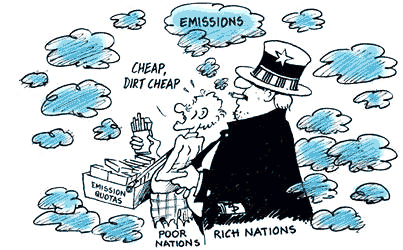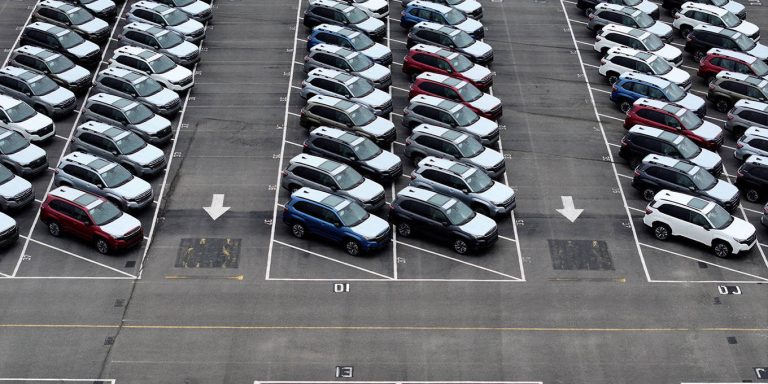
Flexibility mechanisms were defined in the Kyoto Protocol (COP3) as different ways to achieve emissions reduction as part of the effort to address climate change issues. These have been highly controversial as they were mainly included on strong US insistence and to keep the US in the treaty. These fall into the following categories discussed below:
Emissions Trading
Emissions Trading, or Carbon Trading as it is alternatively known, involves trading carbon emission credits within nations.
- Allowances turn emissions into a commodity that can be traded between industries.
- By starting with a limit which would gradually be reduced each year, the remainder emissions are then available to use, or trade if you do not use them yourself.
- As limits are reduced each year companies have to find ways to reduce their emissions, through innovation and change or trade.
Supporters say that this mechanism will bring in private corporations by putting a price on carbon, creating market pressures driving for efficiency, innovation and the best results.
The Kyoto Protocol says that it is ok to trade in emissions, but that it should not be the major means to achieve one’s commitments.
Some European countries and corporations have started implementing such programs to get a head start and to see how well it will work, while in Chicago, USA, a green house gas emissions trading market is emerging. Chicago and Mexico City are, for example, joining the carbon trading initiative.
The proponents of carbon trading believe that such markets can be useful in gaining experience and developing standard framework for monitoring emissions. It can also help in discovering the price of reducing GHGs [greenhouse gases]. But opponents feel that stress should be on undertaking real reductions by cutting fossil fuel use causing GHG emissions rather than on purchasing the right to pollute by buying emission allowances.
Critics argue that it will be easier to buy credits than to reduce emissions hence it won’t really work and will just be a license to pollute.
Because of the collapse of the former Soviet Union, the emissions from the countries of the former Soviet Union is much reduced, but under the Kyoto agreements, they can emit up to their 1990 limits. In essence then, trading at 1990 limits could lead to more emissions, as summarized by the following:
[I]n the period up to 2012,
hot-airtrading could actually lead to an increase in global emissions. Under the Kyoto Protocol, Russia and the Ukraine secured the right to stabilise their emissions at 1990 levels by 2012. Since their economies collapsed after 1990, Russia and the Ukraine’s emissions are currently far below 1990 levels. On paper, these two countries will thus be allowed to increase their emissions by 50% and 120% respectively by 2012. However, their industries will not conceivably be able to grow this fast. Instead, they will be able to sell much of that entitlement to other countries. The United States has already made clear its intention to purchase thishot airin order to achieve a substantial proportion of its reduction requirement.

Back to top
Clean Development Mechanism
The Clean Development Mechanism (CDM) is similar to the joint implementation, but where developed countries invest in Southern, or developing countries. It is aimed to be a part of a program of sustainable development.
For some developing countries, this is important because of the possible attraction of foreign investment.
However, there have been many concerns:
- Critics argue that rich countries can avoid responsibilities at home and that it will actually increase emissions because the credits earned will allow rich countries to emit more, while developing countries are not tied to reduction at this stage (because it is unfair to penalize them for what is internationally recognized as largely something caused by the rich countries. See the Climate Justice and Equity section for more about this aspect.)
- It is also criticized that instead of important technology transfer to developing countries (so that they are empowered to develop and produce themselves), the free-trade mechanisms will instead lead to further dependency (and, ironically, on the very multinational corporations that are criticized for being the heaviest polluters.)
- By treating emissions as commodities, the structural inequity we see between North and South in commodity trading in general is feared to continue.
- In essence then, this is criticized for allowing the rich countries to continue using and burning fossil fuel while paying the third world not to.
- Additionally, as Centre for Science and Environment (CSE) points out, the rich get to use the poor countries’ land to tackle their own emissions issues, not to help the poor, while not actually concentrating on reducing emissions. The Corporate Europe Observatory also has concerns in this area:
Many corporate ventures that might become eligible for emissions credits — nuclear power plants, so-called
clean coal
plants as well as industrial agriculture and large-scale tree plantations (including genetically engineered varieties) — have extremely serious negative social and environmental impacts. Investments incarbon sinks
(such as large-scale tree plantations) in the South would result in land being used at the expense of local people, accelerate deforestation, deplete water resources and increase poverty. Entitling the North to buy cheap emission credits from the South, through projects of an often exploitative nature, constitutescarbon colonialism
. Industrialised countries and their corporations will harvest thelow-hanging fruit
(the cheapest credits), saddling Southern countries with only expensive options for any future reduction commitments they might be required to make.Saving
the Kyoto Protocol Means Ending the Market Mania, Corporate Europe Observatory, July 2001 - It is also controversial because many questions were raised for the Hague conference. For example:
- Limits have not been agreed to (or it has not even been agreed if there should be limits.)
- It is not clear what the range of activities are that can be included. Nuclear energy, hydropower, renewable energy only are some of the uncertainties.
- Public participation and monitoring is paramount.
- Will a form of energy tax work?
- Accountability and verifiability of emissions and credits etc is very difficult as stocks and flows of emissions are hard to quantify.
- Futhermore, as the Corporate Europe Observatory points out, the trade in emissions resulting in carbon credits would lead to
unequal property rights to the atmosphere
which in turnwould consolidate the historic overuse by Northern industry at the expense of the South (80% of all CO2 emitted since 1850 has come from the North). A market without clearly defined property rights can never function and the unfair property rights that underlie the currently proposed emissions markets will eventually be rejected by those losing out.
- As CSE further point out to the lead up to the COP8 meeting in October 2002, CDM is still an issue:
Strong rules for permanence, additionality, leakage, assessing the impact on the local population and measures to reduce uncertainty need to be applied otherwise CDM would just end up being a cheap way for industrialised countries to meet their targets without making any changes domestically.
What’s Up for Discussion at CoP-8?, CSE Briefing Note, October 25, 2002 (link is to a PDF-formatted article.)
Back to top





